Big Wave Surfer Kai Lenny Knows What It's Like to Be Buried Alive
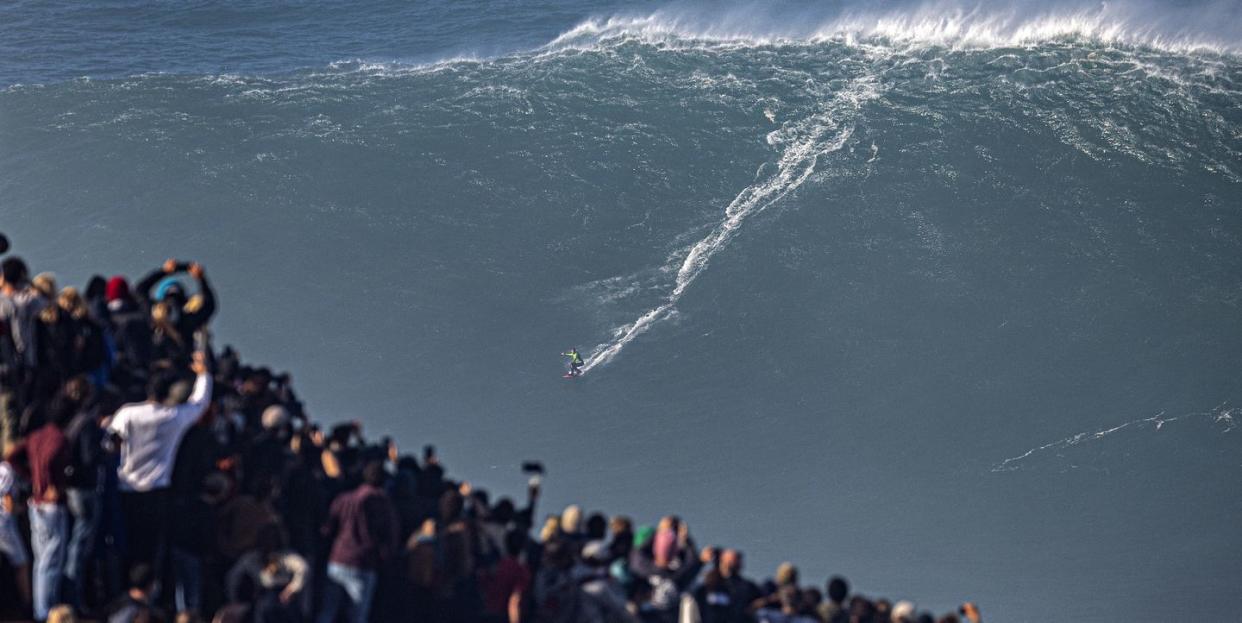
Shortly after a jet ski towed him onto his first wave of the day, Kai Lenny zipped across the top of a Nazaré monster and launched himself into an aerial 360. He landed, for a moment and change, with smooth dexterity, the front third of his board suspended over the rushing cliff of water. And then he skidded down the face of the wave—feet and board slipping forward, torso tumbling backwards, arms waving about in desperate search of the balance he almost never loses. It was gone. In that moment at the 2020 Nazaré Tow Surfing Challenge, Lenny cartwheeled into the abyss. This is big-wave surfing in the style of Kai Lenny, the 30-year-old from Maui who is doing things on giant swells that no one, outside his frequent tow-surf partner Lucas Chumbo, has ever done.
And this is surfing at Praia do Norte in Nazaré, Portugal. It’s the kind of place that hatches tales of sea monsters and the wrath of Poseidon, the sum of all kinds of geological anomalies and freakish oceanography. The wave at Nazaré is really multiple waves coming together out of a 10,000-foot trench just offshore, a ferocious aggregate of raw power and devilish microcurrents, one of which sent Lenny spinning in 2020. This is where Brazilian surfer Marcio Freire drowned in January, pulled into the viper pit of currents in the “impact zone," that space before the shore where the wave's lip falls like a guillotine. The wave at Nazaré is not like other big-wave spots. The churn of the maelstrom digs up sand and spits foam with a kind of Atlantic rage. The peak months are winter, November to March, when surfers come out in the fog and cold after nights where the ground shakes as the surf beats against the rock beneath the Forte de São Miguel Arcanjo and its iconic red lighthouse. Lenny has called it “survival surfing.”
Yet it’s where he’s done some of his very best work. Not long after his involuntary cartwheel, Lenny was back up on his board and seizing his control to zip down a picture-perfect wave as it curled behind him—a giant barrel, a geometry-class doodle come to 70-foot life. It won him the World Surfing League's Biggest Wave of the Year. It's another addition to the stack of accolades from all the watersports he competes in: hydrofoil, kitesurfing, stand-up paddling, windsurfing, outrigger canoe, and more. Lenny is a waterman, among the most accomplished alive, and yet he admits the terror of Nazaré has not faded. It never will.
Esquire caught up with him ahead of the 2023 edition of the Tow Surfing Challenge to learn what it’s like to be trapped underwater at the world’s most perilous big-wave spot, what you can’t understand about these waves just watching on YouTube, and the shadow that tells you you're about to get destroyed.
Do you remember the first really big wave that you surfed?
When I was coming up, I had been watching Pe'ahi—”Jaws,” which is in my backyard right here—my whole life. And then my heroes, Laird Hamilton and Dave Kalama, offered to take me out. I remember my first wave I ever foiled out at Jaws. I felt another level of power. There are a few spots like that in the world. It’s Nazaré, Mavericks, Teahupoo, Cloud Break in Fiji, Jaws, and the Cortes Bank.
But it wasn't until the first time I fell—I was getting towed in by Dave Kalama at Jaws a year later, when I was 17. Underwater, I just thought I was going to die, because it was so violent and like nothing I'd ever experienced. I'm like, Well, I've lived a good life. It's over. The big wave just feels like an atomic bomb going off underwater. The only rhythm is you getting pulled up and down. Imagine being in a car accident for an entire minute. I hope you've never been in one, but the violence and the jolting—it's that for a minute long. You feel like your eyeballs are going to pop out of your head. You can feel the pressure on all your joints, everything getting stretched out.
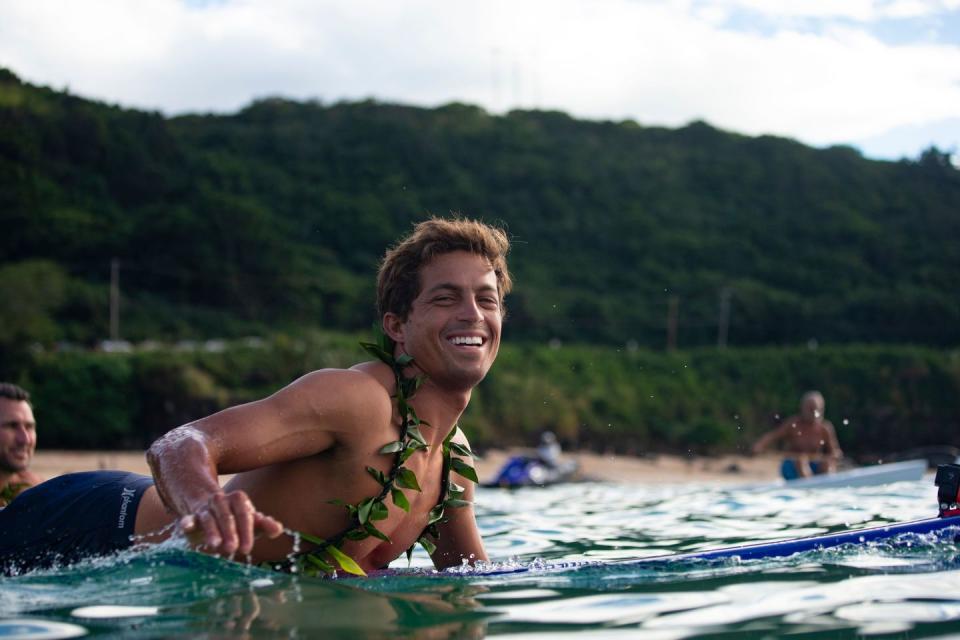
I've seen you wipe out at Nazaré back in 2020. Where does that rank among those car crash times?
Nazaré is an initial really first big hit, but then it's a long hole down. You feel like you're trapped under the Atlantic—you feel like you've been buried alive. You pull your inflation vest and start to come up to the surface. You're almost counting the seconds because the time between two waves, is really tight. You're just hoping you get up for one breath before the next one comes. Or you're hoping that you get dragged in far enough that you're out of the initial explosion area.
If you fall in the wrong place at Nazaré, because it's such a converging peak, it could probably just kill you on impact. Luckily, there’s a benefit to the wave being so big: we're so small that when it hits you, it kind of just steamrolls over you like a pebble on the road. You don’t have a ton of surface area to get ripped in half. It's astonishing that more people haven't passed away. But we had a friend that drowned at Nazaré a couple weeks ago. The last few years, with the advancements in technology, the equipment allows you to survive these waves and push the limits.
If someone's watching on YouTube, what are they not seeing and experiencing about being on that wave?
You just can’t put it into words. It's like trying to describe a color to somebody who's never seen before. How do you explain orange? How do you explain blue? You almost have to experience it for yourself to have an opinion. That’s why I encourage everybody to see for themselves, whether it's showing up to Nazaré on the cliff or going out to watch. You realize how much energy these waves have. It's like an invisible force. Sometimes the tallest waves don't feel the biggest, if that makes sense. Sometimes waves are maybe 20 feet smaller in vertical height, but when you're riding them you're going way quicker and when you fall it's ten times more violent. You just can't believe the human body can sustain such an explosion.
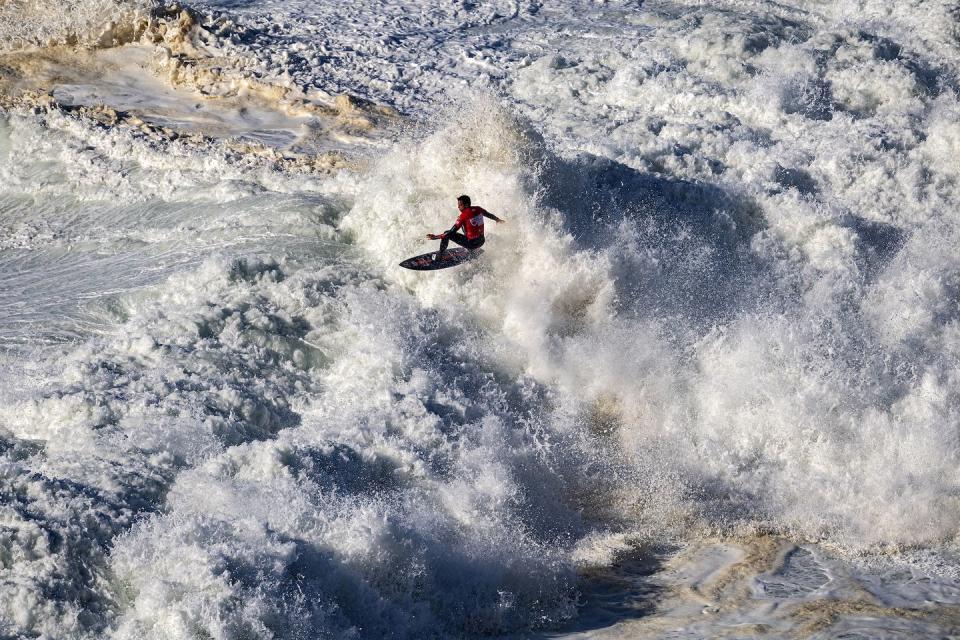
Do you remember the first time you laid eyes on a big swell at Nazaré?
The first time I showed up to Nazaré, it was for the Big Wave World Tour paddling contest. Initially, in our surf world, it was considered a mushy wave. Oh, it’s just a big mushburger. If you fall there’s no consequences. I can remember walking on the cliff. It was a cold onshore breeze kind of day, and no one was around. It was before Nazaré was really popular and there weren't 50,000 people on the cliff. And I can remember laying my eyes on these waves and they were just top-to-bottom the gnarliest shore break I've ever seen. This is not a mushball. If you can measure power and weight, it’s probably top three—one of the heaviest waves on planet earth.
It was one of the most terrifying first events I've ever done. I lost my first heat, and I almost swore to myself that I'm never coming back here. This place is too gnarly, it's too scary, and it's not perfect like Jaws. It's not this perfect wave that's big—it's just this mountain that's avalanching down and wants to eat everything in its path. Then I thought about it more. I couldn't live the rest of my life knowing that this wave got the better of me. I ended up spending the next many, many years going back, and won contests along the way. It’s still scary, but it’s a lot of fun because there’s performance potential that other places don’t have.
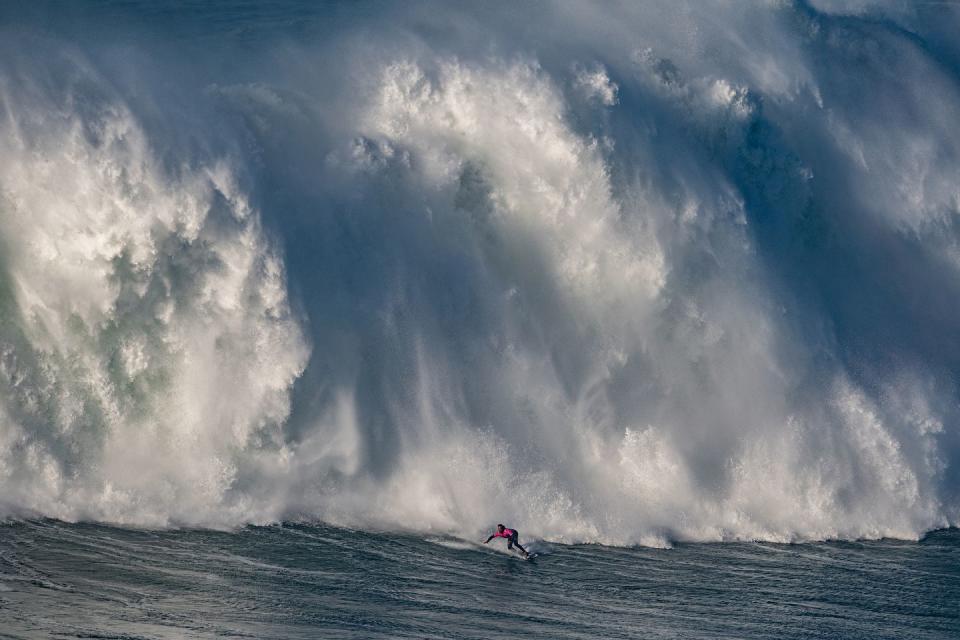
The crowd comes to watch amazing surfing, but some of what people are waiting for is for somebody to wipe out and get demolished. Is that a weird feeling as a competitor, knowing that people are waiting for something not-great to happen?
Everyone loves carnage—and you'd hope that people don't maliciously want you to get hurt. But it's pretty fun to watch when people are wiping out. It feels like sometimes you're a gladiator being thrown into the Thunderdome, and you have to fight your way against the lion. There are times when it's ruthless. You're getting pounded on the rocks and you can hear the crowd almost cheering and laughing. They want you to get destroyed.
Garrett McNamara has talked about how it's his job to be a big wave surfer—so he needs to push the envelope and accomplish something new every year. Is that how you feel, that it's your job to push the limit?
When I started surfing big waves, I wasn't necessarily sponsored to be a big wave surfer. I was doing other sports as well. I was surfing small waves, but I was also windsurfing, kite surfing, riding hydrofoil. For me, it was kind of the Mount Everest to be a performer on big waves. If I could ride the biggest wave ever ridden, that'd be great, but it's not something that I chase after. I want to do what snowboarders do in Alaska on giant mountains. I want to ride these waves, this canvas, in a way that no one has ever done it.
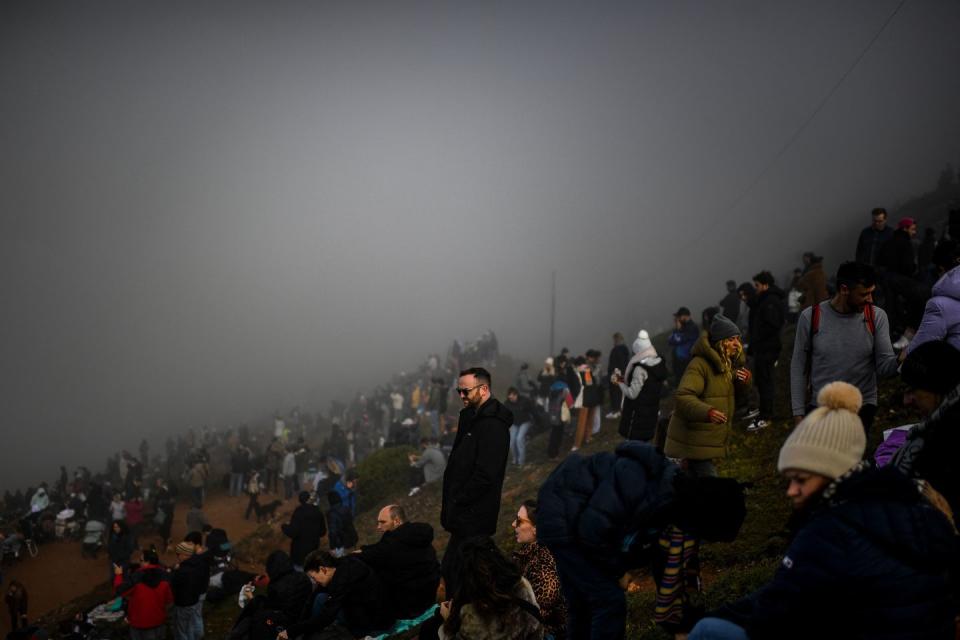
I suppose I feel the pressure of it, but at the same time, doing these 360s on big waves, I don't think it really matters to anybody... It's more like I want to do this trick. There are days where you feel like a rockstar because you're walking down the beach and there's 50 to 80,000 people cheering, and you're going out into a place no one on that beach would want to go. But most of the best rides I ever had, the only fans that are there are the palm trees swaying. They’re my only witnesses sometimes.
In 100 Foot Wave, McNamara raised concerns about the safety protocols back in 2020, and of course Alex Botelho got injured that year. Are you confident in how these events are designed?
I was actually in that heat with Alex Botelho, the last heat of the day. And it was heavy because we could have responded, but we didn't know what was going on. You don't know that somebody's drowning, necessarily, unless you're right there. And I wish somebody would've told us to go in, because we probably could have done the best job since this is what we do every single day. But those guys did do a phenomenal job to save his life. If someone is coming out of it alive, then that's a win.
If you follow things too by-the-book, in the heat of the moment, you're probably going to miss the opportunity. You got to just do whatever you can to get the person out of there. So that was a big eye-opener. There were some protocols that were added. But it just goes to show that you’ve got to trust less in others and more in your tight-knit crew. Because everyone operates just a little bit differently. I don't personally put myself in conditions that I don't think I could handle or swim myself out of on my own. There are those times when you might get knocked on the head and unconscious—but I feel like, knock on wood, I've never been in a situation where I thought I was going to drown.
Is getting barreled, being inside this force of nature, the most rewarding feeling in surfing?
For me, the pinnacle is to ride a giant barrel. That's the scariest commitment you can make, because you're committing to a wipeout and you're putting yourself in the most harm’s way. At Nazaré, it's not a perfect barrel. It's not like here at Jaws. It's more like a live, angry, violent sort of lip. And most of the time you're not going to make it out, but if you time it right, you can. But not every wave barrels. The rest of the time, you perform by hitting these ramps on the wave. There are these five-foot chops headed up the face and instead of just trying to stick to the water and survive it, why not just do tricks off of it? It just adds a degree of difficulty, excitement, fun.
But riding a barrel in any big wave is the most exciting thing you can do, because the sensation is time-stopping. It feels like you're going through a wormhole. Nothing else exists in that moment. Your only focus is that single second. You're not thinking of the future, the past. You're just present. And at the same time, you're breathing underwater.
You Might Also Like

